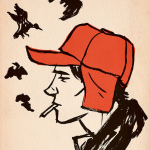Every week in The Kiddy Pool, Erin Newcomb confronts one of many issues that parents must deal with related to popular culture.
“Where most Americans see a juxtaposition of purity and corruption, one that offends our sensibilities, those views of children and smoking are not shared everywhere around the world.”
I remember eating candy cigarettes when I was a kid. It was a stick of bubblegum, with sugar powder in the wrapper, so you could blow out the powder and pretend to smoke. These candies are now sold as “nostalgia” products, so that makes me feel super, but that’s by the by. Recalling my experience with candy cigarettes is sort of like watching scenes from Mad Men where pregnant women smoke and parents pile the kids in the front seat of the car with no seat belts. Times have changed.
And, with regard to childhood smoking (yeah, even candy) and seat-belt usage, I feel that’s for the best. Despite that claim, I was intrigued by the new Frieke Janssens exhibit “Smoking Kids”. The headline in The Atlantic asks “5-Year-Olds with Cigarettes: Glamorous or Hideous?” I think, in a way, it’s both, and that it’s supposed to be both. The images themselves are beautiful, and, no, the children were not given actual cigarettes. I particularly like the one entitled “Ringlings” and the way it recalls a child-version of Betty Draper Francis, just rolled out of bed and ready for a morning smoke. Just to be clear, I don’t think that children should smoke (or adults for that matter), and I don’t think that’s Janssens’ argument either; the purpose of her art seems more about deconstructing social norms rather than advocating personal or social policies. To that end, her art is effective. It’s disturbing to see children smoking, just like my memory of the candy cigarettes is disquieting.
What’s different is that those candies had their heyday in a cultural moment where smoking was not nearly as vilified as it is today. Joe Camel stuck around until 1997 and legislation to make bars and restaurants smoke free in NYC didn’t happen until 2003. The anti-smoking crusade is relatively new, much newer than the history of old-Hollywood glamour where cigarettes and smoke worked as props and plot devices to signal desire and romance and power. Now, villains are more likely to be the smokers, and smoke signals evil not because smoking has changed, but because our cultural perceptions of smoking and smokers have changed. For an irreverently funny analysis of smoking, check out the 2005 film Thank You for Smoking. One anti-tobacco lobbyist tries to replace cigarettes in old films with other props that look absurdly out of place, while the PR rep. for big tobacco pushes for Hollywood inclusion:
Jeff Megall: Sony has a futuristic sci-fi movie they’re looking to make.
Nick Naylor: Cigarettes in space?
Jeff Megall: It’s the final frontier, Nick.
Nick Naylor: But wouldn’t they blow up in an all oxygen environment?
Jeff Megall: Probably. But it’s an easy fix. One line of dialogue. ‘Thank God we invented the… you know, whatever device.’”
The movie clearly pushes the idea that Big Tobacco and its affiliates are the epitome of evil. It’s that wickedness, so obvious to our culture today, that makes Janssens’ work so disturbing. Children are supposed to be innocent, pure, protected.
That’s the angle a Thai anti-smoking campaign takes, where kids ask for a light to manifest to adults how damaging cigarettes are. But where the interpretation of smoking as sinful is now obvious in the U.S., that’s simply not the case in every country; take China, for instance, where companies see a growing market for a product that’s declining here in the states. Janssen is not American, and her art points to the reality that readings of children and readings of smoking are not universal but particular. Where most Americans see a juxtaposition of purity and corruption, one that offends our sensibilities, those views of children and smoking are not shared everywhere around the world. When I look at “Ringlings,” I don’t feel revulsion or umbrage, but sadness. It’s sort of like looking at the child version Betty Draper Francis and recognizing why she smokes, why she’s an addict and all-around miserable human, because she, like so many children (fictional and non-fictional) never knew the innocence and protection that we pay lip-service to at the altar of childhood nostalgia. The belief in childhood as a state of untainted goodness is, one might say, merely smoke and mirrors.












